2012 was a good year for minimalist trail shoes. Two of my personal favorites were the VIVOBAREFOOT Breatho Trail and the Inov-8 TrailRoc 235. What is there to like? Both shoes are zero drop, they provide good flexibility, they have gnarly lugged outsoles, a nice anatomic last, and quick-drying mesh uppers. Pretty much all of the properties I am looking for in a trail shoe for hiking, backpacking, and off-road running.
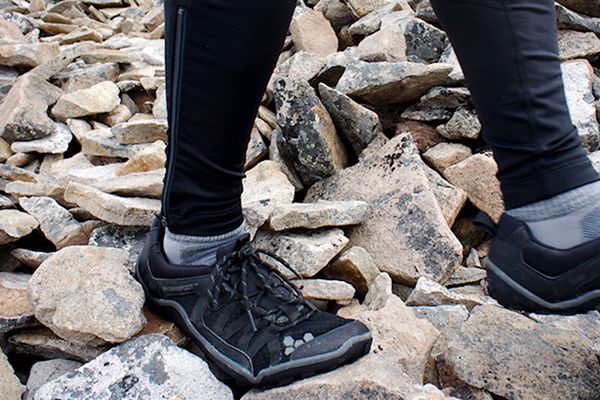
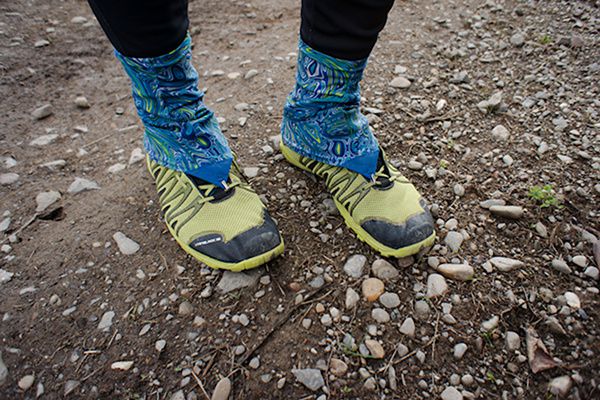
Soles
Outsole
The Breatho Trail and the TrailRoc both have outsoles well suited for use over a wide range of trail and off-trail conditions ranging from hardpack to loose and sloppy.
The lugs on the Breatho Trail are relatively deep (4.5 mm), widely spaced, and somewhat thin - rather than being "blocky", they are v-shaped. The thin lug design makes them quite flexible (you can flex the lugs with your finger), which has some traction advantages in certain situations (such as rock). The widely spaced lugs give them good grip in loose, soft, and wet terrain. The thinness of the lugs however means that they are less well suited to hardpack conditions, and most definitely not suited for pavement or concrete. If you are the type of person who has some city miles to do before hitting the trail, this outsole is not going to be ideal.
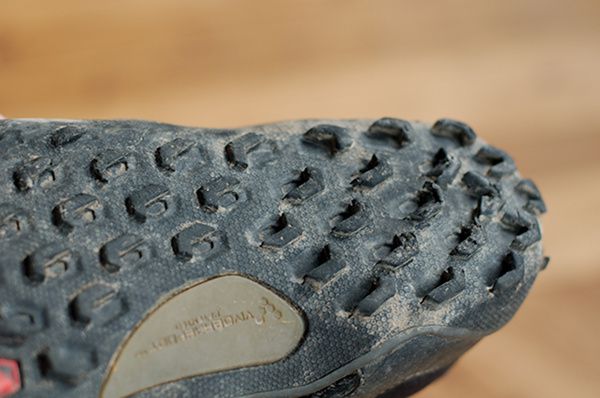
The lugs on the TrailRoc are of similar depth (measured at approximately 4.5 mm), blocky, and relatively widely spaced. Although the lugs are not as widely spaced as the Breatho Trail, the traction was still found to be excellent both on and off the trail. One advantage of the TrailRoc lug size and spacing is that they fare a little better than the Breatho Trails on hardpack. They also have the potential to work a little better on pavement or concrete, although I did not test them in those conditions.
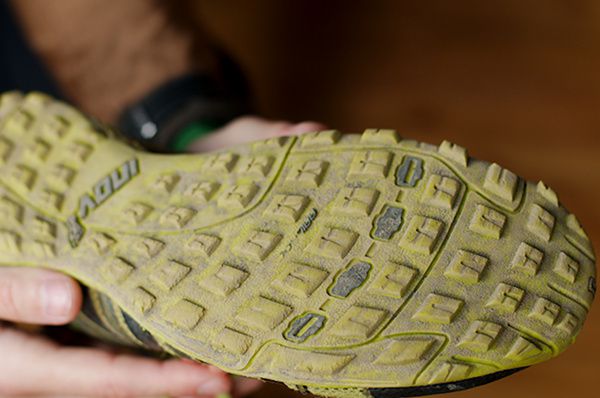
Where the Breatho Trail is made using a uniform rubber compound, the TrailRoc is concocted out of three rubber compounds, called the Tri-C compound. Endurance rubber is used in high wear areas (from heel to forefoot of the shoe), soft sticky rubber is used in the toe and arch area to provide good grip, and hard sticky rubber is used on either side of the toe to provide grip with better wear resistance.
After having tested both shoes for quite some time now, I have found both soles to perform very well for trail running, hiking, and backpacking. The biggest downfall for both however is the durability of the lugs. The Lugs on the Breatho Trail tend to wear by flattening, breaking, or squishing (due to their thinness). The lugs of the TrailRoc tend to wear away like an eraser (due to the use of softer rubber compounds). In both cases, I felt that the soles wore much more quickly than I would have liked.
And the winner is... a tie. No sole has really stood out as clearly superior from a grip or wear resistance standpoint.
Rock Protection, Flexibility, and Ground Feel
It is important to start out this section by stating that both of these shoes are very flexible - we are talking about barefoot/minimalist shoes here after all. That being said, flexility and rock protection are relative, as many coming from the traditional trail shoe world would think that rock protection was non-existant in both of these models. What I look for in a trail shoe is enough protection to take edge off the rocks without losing too much in the way of flexibility. I want my foot to be able to conform to the terrain without feeling the sharp edges of scree, thorns, or otherwise. So, when I refer to rock protection here, that is what I am talking about - the degree to which the footwear is able to take the edge off of the rocks.
The approach to rock protection that each company takes is different, but surprisingly, the end results feel about the same. VIVOBAREFOOT's approach is to use a stiff-ish sole composition. In addition to the sole, they have a 3 mm footbed (which can be removed to add more space for larger feet, or to increase ground feel). Inov-8's approach to rock protection is to use a bit of midsole (6 mm), a thin rubber outsole (the TrailRoc 235 does not have a rock plate) and a 3 mm footbed.
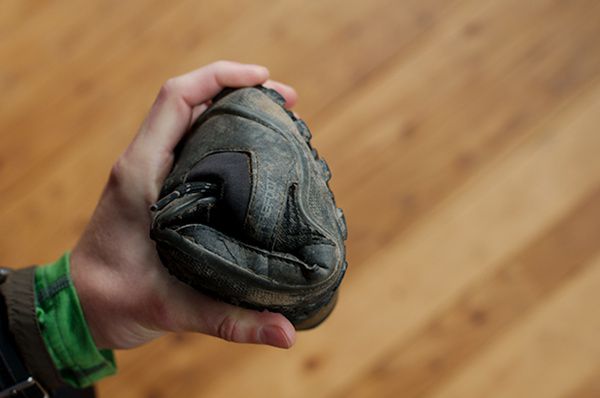
Despite the difference in construction and stack height (i.e. thickness between the bottom of your foot and the ground), I find the flexibility, rock protection, and ground feel of these two models to be more-or-less equivalent. The slightly stiffer sole of the the Breatho Trail and the slightly thicker sole of the TrailRoc more-or-less achieve the same result. In both cases, I think they have really hit a sweet spot between ground feel and protection.
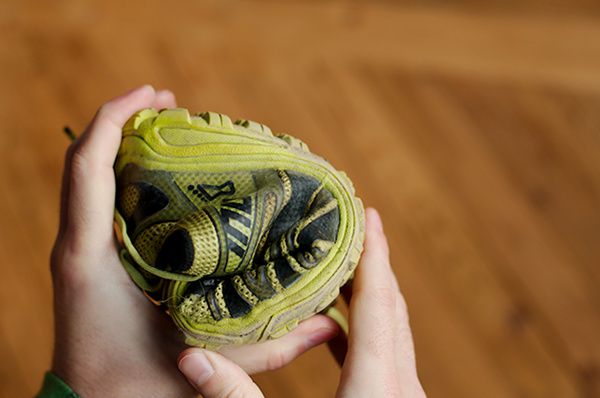
And the winner is... a tie. They both strike a very similar balance between ground feel and protection.
Uppers
Construction
Both the Breatho Trail and the TrailRoc have lightweight mesh uppers. Where they diverge however is in their construction.
The TrailRoc has a very simple upper. It is constructed out a mostly one-piece mesh, with minimal stitching. The uppers have TPU (Thermoplastic Urethane) overlays to provide structure and wear resistance on the sides of the shoe. Additionally, the toe area has a thin texturized plastic/rubber coating to provide a little extra wear resistance to the mesh. The tongue is constructed out of the same mesh as the rest of the shoe.
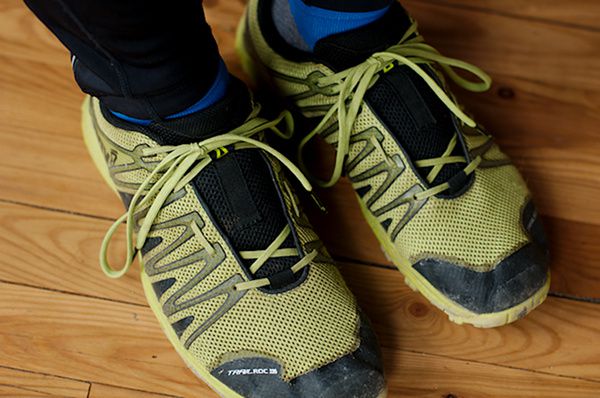
The TrailRoc's thin protective toe coating started to peel around the edges rather quickly after getting them. In an effort to stop what looked like a growing problem, I attempted to re-glue the edges using Seam Grip. That didn't work so well as the Seam Grip did not bond to the coating. The peeling however did not seem to get much worse. I sent an email to Inov-8 informing them of this problem and they told me that it had been identified as a production issue, and that later models should fare better.
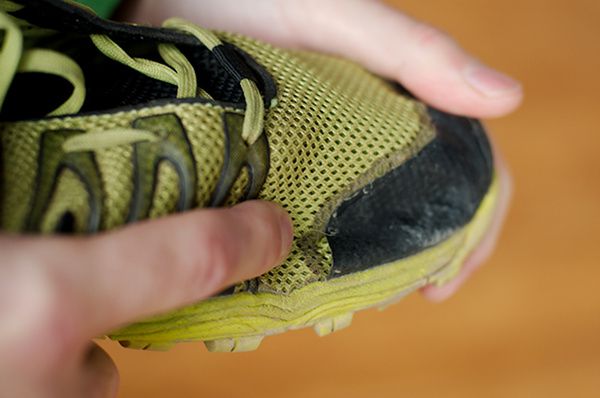
The Breatho Trail has a much more complex design. Lightweight mesh is used over the toes and around the sides of the shoes. Layers of thicker wear resistant fabric are used to protect the lighter weight mesh from abrasion. The area around the shoe opening and the tongue (there really isn't a tongue, but a gusset) is constructed out of a thich-ish stretchy lycra/almost-neoprene like fabric.
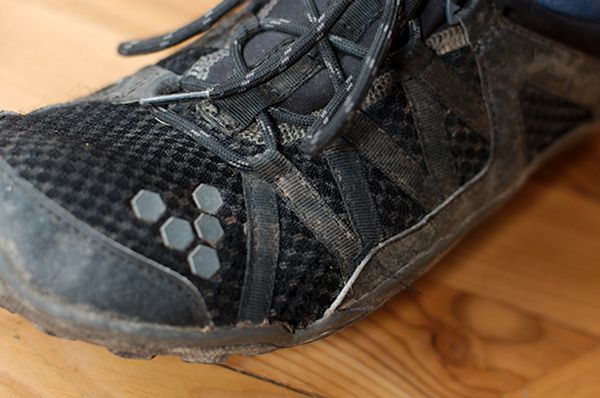
In theory, all of these more robust fabrics should make the Breatho Trail a more durable shoe right? Well, not so much. Yes, the fabrics are durable, but they are held on with thread, and all of that thread is exposed. So while the robust fabric is hard at work protecting your shoes, the stitching is gets worn down and eventually fails causing the uppers to fall apart pre-maturely. To prevent this problem, a coating of Seam Grip over the stitching is highly recommended.
And the winner is... The TrailRoc. The combination of the simple mesh design, the abrasion resistant TPU overlays, and the lack of external stitching gives it the edge.
Fit
Both the Breatho Trail and the TrailRoc use an anatomical last.
The Inov-8 last is narrower in the heel (which gives great heel hold - no slippage here), but also does not offer as much room for the big toe. To feel most comfortable in the Inov-8's, I have had to avoid toe socks and use as thin a sock as possible (my favorite being the Swiftwick Pulse). Even then, I think that some extra room for the big toe would make this shoe a lot better.
The Breatho Trail has a roomier fit all around. The heel is wider (which is not ideal), but the toebox is a lot better, with more room for the big toe. The biggest nit I have with the Breatho fit is the shoe opening - there are gaps. I am not sure if this is due to the lack of tongue, or the larger heel (or both), but it has been impossible for me to get a nice closed fit around the opening. Despite the nits, I have actually found the fit of the Breatho Trail to be very comfortable, and haven't experienced any problems.
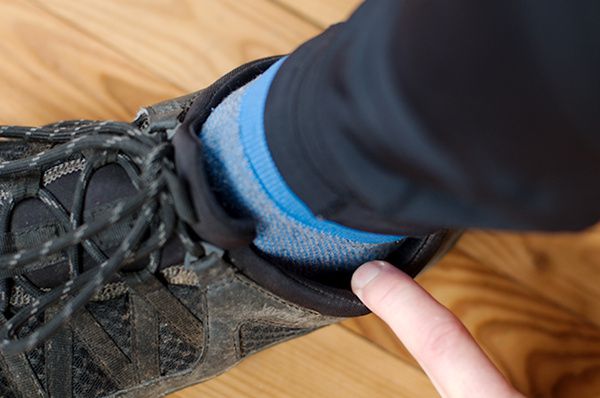
From a big picture standpoint, the fit of the TrailRock does give it an edge on the downhill. That said, the bigger toebox of the Breatho edges it out, especially for all-day comfort - something I look for when I am doing longer activities like hiking and backpacking. If I could have my way, I would love to see a shoe with the heel design of the TrailRoc coupled with the toebox of the Breatho Trail - that would be a nice shape!
And the winner is... the Breatho Trail, for its better (more anatomic?) toebox.
Conclusion
Neck-and-neck. That is how I have found these two shoes to be. There has not been a clear winner from my perspective, and thus they have been in fairly equal rotation. If I were backed into a corner with a gun to my head and forced to make a decision, then I would probably say the Breatho Trail simply because I like the toebox better. If I didn't have such fat toes, then I would probably be more inclined towards the TrailRoc because of the nice mesh uppers. Decisions, decisions! Hopefully this article will arm you with enough info to help you make yours!
